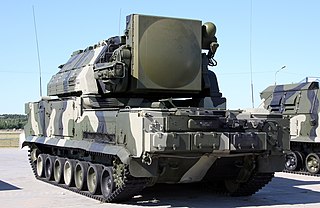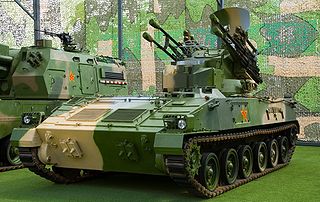
The 9K33 Osa is a highly mobile, low-altitude, short-range tactical surface-to-air missile system developed in the Soviet Union in the 1960s and fielded in 1972. Its export version name is Romb.

The 9K31 Strela-1 is a highly mobile, short-range, low altitude infra-red guided surface-to-air missile system. Originally developed by the Soviet Union under the GRAU designation 9K31, it is commonly known by its NATO reporting name, SA-9 "Gaskin". The system consists of a BRDM-2 amphibious vehicle, mounting two pairs of ready-to-fire 9M31 missiles.

The Buk is a family of self-propelled, medium-range surface-to-air missile systems developed by the Soviet Union and its successor state, the Russian Federation, and designed to counter cruise missiles, smart bombs and rotary-wing aircraft, and unmanned aerial vehicles. In the Russian A2AD network, Buk is located between the S-200/300/400 systems above and the point defense Tor and Pantsir type systems below.

The Tor is an all-weather, low-to medium-altitude, short-range surface-to-air missile system designed for destroying airplanes, helicopters, cruise missiles, unmanned aerial vehicles and short-range ballistic threats (anti-munitions). Originally developed by the Soviet Union under the GRAU designation 9K330 Tor, the system is commonly known by its NATO reporting name, SA-15 "Gauntlet". A navalized variant was developed under the name 3K95 "Kinzhal", also known as the SA-N-9 "Gauntlet". Tor was designed to shoot down guided weapons like the AGM-86 ALCM and BGM-34 day and night, in bad weather and jamming situations. Tor can detect targets while on the move. The vehicle must stop intermittently when firing, although trials have been conducted with the goal of eliminating this restriction.

The 9K35 Strela-10 is a Soviet highly mobile, short-range surface-to-air missile system. It is visually aimed, and utilizes optical/infrared-guidance. The system is primarily intended to engage low-altitude threats, such as helicopters. "9K35" is its GRAU designation; its NATO reporting name is SA-13 "Gopher".

The ZSU-57-2 Ob'yekt 500 is a Soviet self-propelled anti-aircraft gun (SPAAG), armed with two 57 mm autocannons. 'ZSU' stands for Zenitnaya Samokhodnaya Ustanovka, meaning "anti-aircraft self-propelled mount", '57' stands for the bore of the armament in millimetres and '2' stands for the number of gun barrels. It was the first Soviet mass-produced tracked SPAAG after World War II. In the USSR, it had the unofficial nickname Sparka, meaning "twin mount," referring to the twin autocannon with which the vehicle is armed.

The 2K22 Tunguska is a Soviet tracked self-propelled anti-aircraft gun armed with a surface-to-air gun and missile system. It is designed to provide day and night protection for infantry and tank regiments against low-flying aircraft, helicopters, and cruise missiles in all weather conditions. The NATO reporting name for the missile used by the weapon system is SA-19 "Grison".

Ranzhir is a Soviet/Russian mobile command center for several types of Russian anti-aircraft weapons, such as Tor, Tunguska, Strela-10, Igla and Osa.

The Type 95 is a Chinese self-propelled anti-aircraft vehicle. It is armed with four 25 mm caliber cannons and optionally four fire-and-forget QW-2 infrared homing missiles. It was first displayed publicly at the Beijing Military Parade in 1999. Earlier in development the system was designated Type 90-II and Type 90-III.

The MT-LBu is a Soviet multi-purpose fully amphibious armoured carrier which was developed under the factory index Ob'yekt 10 in the late 1960s, based on the MT-LB. It has a more powerful engine, a 40 cm higher hull and a longer chassis with 7 road wheels on each side.

GM is a series of tracked vehicle chassis. Generally, the series is produced by Russia's Mytishchi Machine-Building Plant. Some older series were developed and produced by Velurussian agriculture machinery manufacturer Minsk Tractor Works (MTZ).

The ZSU-23-4 "Shilka" is a lightly armored Soviet self-propelled, radar-guided anti-aircraft weapon system (SPAAG). It was superseded by the 2K22 Tunguska.

The HQ-17 is an all-weather, low to medium altitude, short-range surface-to-air missile system derived from the Tor-M1.
There are several surface-to-air missile design bureaus in Russia, including MKB Fakel, NPO Novator, and DNPP.

The 9M337 Sosna-R (Pine) (SA-X-25) is a Russian radar and laser-guided supersonic two-stage missile. It is used in Sosna-R short range air defense missile system designed to protect military units from air attacks in all types of combat situations, including during march.

The Air Defense Forces (လေကြောင်းရန်ကာကွယ်ရေးတပ်ဖွဲ့) is one of the major branches of Tatmadaw. It was established as the Air Defence Command in 1997, but was not fully operational until late 1999. It was renamed the Bureau of Air Defence in the early 2000s. In early 2000, Tatmadaw established the Myanmar Integrated Air Defence System (MIADS) with help from Russia, Ukraine and China. It is a tri-service bureau with units from all three branches of the armed forces. All air defence assets except anti-aircraft artillery are integrated into MIADS.
This page is based on this
Wikipedia article Text is available under the
CC BY-SA 4.0 license; additional terms may apply.
Images, videos and audio are available under their respective licenses.
















